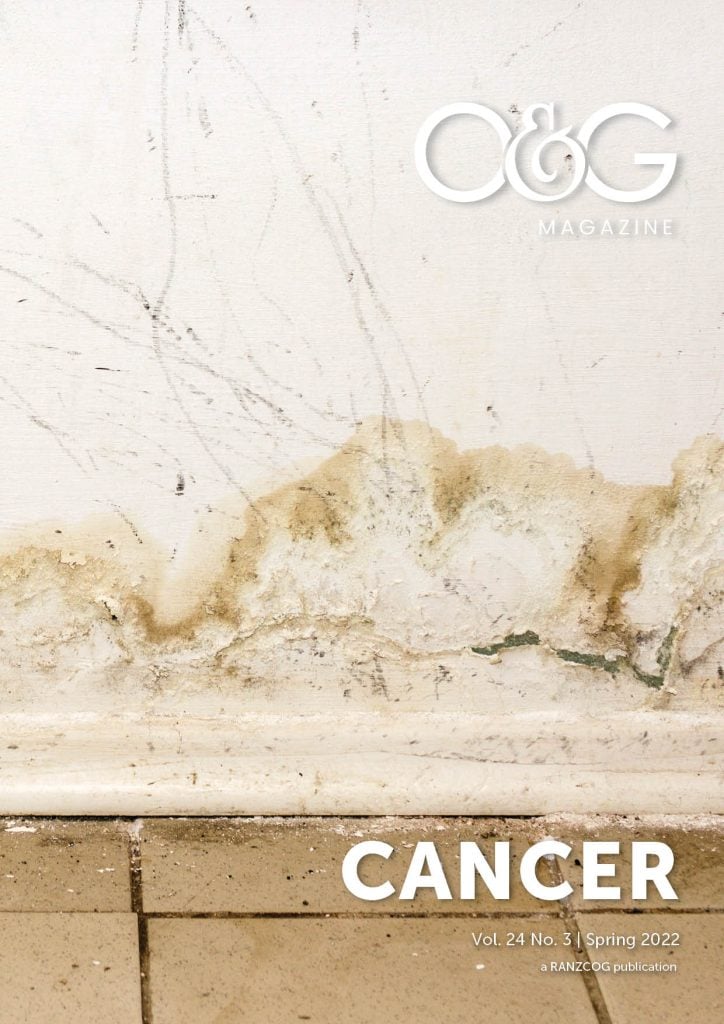The mainstay of treatment for advanced epithelial ovarian cancer (EOC) remains a combination of surgical debulking and systemic therapy. There have been considerable treatment advances in both the primary and recurrent setting over the past several years. New assessment tools to identify patients most suitable for primary upfront cytoreductive surgery, the rise of neoadjuvant chemotherapy (NACT) as well as the development of treatments based upon patient and tumor genetics have shown promise in improving disease-free survival and overall survival. The expanding role of Poly ADP-Ribose polymerase (PARP) inhibitors offers a further armament in the treatment of ovarian cancer in both the primary and recurrent setting. Whilst ovarian cancer remains the most lethal of all gynaecological malignancies (with over 1000 deaths in 2019), there is considerable promise on the horizon.1
Primary management of advanced ovarian cancer
Whilst the standard of care for advanced EOC remains the application of maximal surgical effort in a primary debulking surgery (PDS) to resect all visible disease followed by adjuvant platinum and taxane-based chemotherapy, the role and timing of surgery has been refined on the basis of recent studies. The application of maximal surgical effort in order to obtain the least residual disease possible remains the largest prognostic factor in determining progression-free and overall survival.2 3 4 But this surgical effort often carries with it perioperative morbidity and mortality due to the extent of surgical resection and frailty in this patient cohort.5 There exists no consensus on which patients will benefit most from PDS, although various scoring systems to determine surgical resectability and suitability for surgery exist.6 7 There has been an increasing trend to utilise NACT here and internationally especially for stage 4 EOC where resectability is less assured or not possible due to frailty.8 9
The publication of EORTC 55971 and the CHORUS trials both demonstrated non-inferiority of NACT to PDS in advanced ovarian cancer with similar progression-free survival and overall survival.10 11 Both studies also demonstrated lower perioperative morbidity.12 13 This is not without controversy with two subsequent studies (the JCOG0602 and SCORPION trial) not showing non-inferiority of NACT and superiority of NACT respectively.14 15 However large population based retrospective studies have shown that PDS is associated with better outcomes.16 17 Despite this controversy Farrell et al conducted a survey of Australian gynaecological oncologists in 2018 showing a significant increase in the use of neo-adjuvant chemotherapy in 2017 vs 2007 (43% vs 16%).18 The outcome of the currently underway TRUST trial, a randomised multicentre trial seeking to determine optimal surgical timing in advanced ovarian cancer, should be reported in 2024 and will likely further define which patients benefit greatest from PDS.19
Laparoscopic debulking in ovarian cancer
Given the improved perioperative outcomes inherent in minimally invasive surgery there has been hope that its safety and equivalence in ovarian cancer may be demonstrated. Most information regarding its safety has been in early-stage disease patients and post NACT settings where emerging data suggests it may be safe and feasible with equivalent oncological outcomes.20 21 The role of laparoscopic primary debulking surgery is less clear. Whilst retrospective feasibility studies exist and it may be suitable in select patients, the tumour distribution, limitations of laparoscopic vision and surgical necessity are yet to be addressed by randomised trials compared with open surgery.
Surgery for recurrent disease
Secondary surgery (SCS) was historically considered appropriate in patients who had a long disease-free interval following primary surgery and chemotherapy with oligomestastatic or very small volume disease. There are multiple predictive models that have been developed to identify the patient that would most likely benefit from SCS. This includes the DESKTOP AGO Criteria, Memorial Sloan Kettering (MSK) Criteria and the Tian/iModel Score.22 23 24
The selective use of surgery in recurrence has been supported by two randomised controlled trials DESKTOP III which showed an improvement in progression-free survival (14.0 months to 19.6 months) and SOC 1 which showed an improvement in PFS of 5.5 months in the surgery group GOG 213 showed that the hazard ratio for death (surgery vs no surgery) was 1.29 (95% confidence interval [CI], 0.97 to 1.72; P=0.08), which corresponded to a median overall survival of 50.6 months compared to 64.7 months.25 26 27 The key to SCS requires a tailored application to patients that will benefit the most with a good functional status, low volume disease and a high likelihood of complete resection.
Anti-angiogenic treatment
The use of antiangiogenic therapy in advanced ovarian cancer has been refined following increasing evidence supporting its usage in high-risk patients with advanced disease. Recent subgroup analysis of GOG 218 and the British ICON7 trial showed patients with newly diagnosed stage IV EOC disease with residual or unresectable disease experienced an overall survival benefit (in the subgroup analysis of GOG 218 this was a difference of 10 months vs placebo).28 29
Other indications for the use of antiangiogenic therapy includes recurrent disease and platinum resistant EOC with an improvement in PFS.30 31
PARP inhibitors
PARP inhibitors (PARPis) prevent the repair of single stranded DNA breaks and are thus particularly effective against tumours with existing DNA repair mutations. Because of this PARPis were initially employed in the setting of BRCA mutated disease (either germline or somatic) in the recurrent setting. The publication of the SOLO1 study in 2018 assessed the use of a PARPis (olaparib) in the upfront setting as maintenance therapy following standard surgery and chemotherapy in a patient with either a germline or somatic BRCA mutation.32 391 patients were included in the study with 60% of the olaparib patients remaining disease free at three years vs 27% in the placebo arm.33 Further trials assessing PARPis in the upfront setting have continued to demonstrate a progression-free survival increasing with their upfront usage.
Genetic testing for ovarian cancer
Guidelines recommend that all women diagnosed with epithelial ovarian cancer undergo germline genetic testing, particularly for BRCA1/2 mutations.34 This testing helps determine risk for the patient and their family, as well as guiding further treatment. To improve uptake of this service, some units have implemented ‘mainstreaming,’ whereby systematic genetic testing is implemented via oncology clinics.35 Positive genetic testing for a BRCA1/2 mutation has significant implications on patient’s families. Relatives who then go on to be diagnosed with the mutation themselves are advised to undergo specialist input regarding their breast and ovarian cancer risk, with risk reduction surgery recommended. Surveillance CA 125 blood test and pelvic ultrasound are not recommended in those known to have BRCA1/2 mutation.
Heated intraperitoneal chemotherapy
Heated intraperitoneal chemotherapy (HIPEC) has existed since the 1980s and its role in treatment of epithelial ovarian cancer has varied during that time. It broadly encompasses the perfusion of heated chemotherapy (primarily cisplatin in most studies) intraoperatively immediately following cytoreductive surgery. This confers a higher concentration localised to the peritoneal cavity, the chief site of tumour recurrence, and provides the synergist effect of hyperthermia. OVHIPEC 1 was a multicentre trial whereby 245 patients with newly diagnosed stage III epithelial ovarian, fallopian tube, or peritoneal cancer were randomised to interval cytoreductive surgery with or without the addition of HIPEC following administration of neoadjuvant chemotherapy.36 These patients had been referred for neoadjuvant chemotherapy as their disease was too advanced for primary cytoreductive surgery or initial surgery was suboptimal. Results from this study showed longer disease-free recurrence and survival time in those who received HIPEC. Rates of adverse events were similar in both groups and there was no negative impact on health-related quality of life.37 PRODIGE-7, another multicentre trial, randomised 265 patients with colorectal peritoneal metastases to HIPEC plus cytoreductive surgery or cytoreductive surgery alone.38 This study, however, found an absence of overall survival benefit with the addition of HIPEC and higher rates of late postoperative complications. The conclusions from this paper have drawn much criticism and it has been suggested that it should not be used to discredit other studies.39 Further studies into HIPEC such as HYNOVA, an ongoing Australian study, as well as the eventual outcomes from OVHIPEC-2 will likely go some way to determining the role of HIPEC in advanced ovarian cancer treatment into the future.40 41
Conclusion
Whilst the essential tenants of ovarian cancer treatment remain cytoreductive surgery either before or after platinum and taxane-based chemotherapy, there is ongoing refinement in its implementation and the augmentation of new systemic therapies. Ovarian cancer treatment must be individualised to the patient’s clinical status, institutional strengths and availabilities and tumour biology. As the outcomes from more quality multicentred randomised trials in the field are reported, it is likely there will be further refinements in care provision to improve outcome for ovarian cancer sufferers.
Our feature articles represent the views of our authors and do not necessarily represent the views of the Royal Australian and New Zealand College of Obstetricians and Gynaecologists (RANZCOG), who publish O&G Magazine. While we make every effort to ensure that the information we share is accurate, we welcome any comments, suggestions or correction of errors in our comments section below, or by emailing the editor at [email protected].
References
- Australian Institute of Health and Welfare 2019. ACIM (Australian Cancer Incidence and Mortality) books. Canberra: AIHW. Available from: www.aihw.gov.au/reports/cancer/cancer-in-australia-2019/summary
- Griffiths CT. Surgical resection of tumor bulk in the primary treatment of ovarian carcinoma. Natl Cancer Inst Monogr. 1975;42:101-4.
- du Bois A, Reuss A, Pujade-Lauraine E, et al. Role of surgical outcome as prognostic factor in advanced epithelial ovarian cancer: a combined exploratory analysis of 3 prospectively randomized phase 3 multicenter trials: by the Arbeitsgemeinschaft Gynaekologische Onkologie Studiengruppe Ovarialkarzinom (AGO-OVAR) and the Groupe d’Investigateurs Nationaux Pour les Etudes des Cancers de l’Ovaire (GINECO). Cancer. 2009;115(6):1234-44.
- Bristow RE, Tomacruz RS, Armstrong DK, et al. Survival effect of maximal cytoreductive surgery for advanced ovarian carcinoma during the platinum era: a meta-analysis. J Clin Oncol. 2002;20(5):1248-59.
- Rauh-Hain JA, Melamed A, Wright A, et al. Overall Survival Following Neoadjuvant Chemotherapy vs Primary Cytoreductive Surgery in Women With Epithelial Ovarian Cancer: Analysis of the National Cancer Database. JAMA Oncol. 2017;3(1):76-82.
- Llueca A, Climent MT, Escrig J, et al. MUAPOS working group (Multidisciplinary Unit of Abdominal Pelvic Oncology Surgery). Validation of three predictive models for suboptimal cytoreductive surgery in advanced ovarian cancer. Sci Rep. 2021;11(1):8111.
- Suidan RS, Ramirez PT, Sarasohn DM, et al. A multicenter assessment of the ability of preoperative computed tomography scan and CA-125 to predict gross residual disease at primary debulking for advanced epithelial ovarian cancer. Gynecol Oncol. 2017;145(1):27-31.
- Nicklin JL, McGrath S, Tripcony L, et al. The shift toward neo-adjuvant chemotherapy and interval debulking surgery for management of advanced ovarian and related cancers in a population-based setting: Impact on clinical outcomes. ANZJOG. 2017;57:651-8.
- Patel A, Iyer P, Matsuzaki S, et al. Emerging Trends in Neoadjuvant Chemotherapy for Ovarian Cancer. Cancers (Basel). 2021;13(4):626.
- Vergote I, Tropé CG, Amant F, et al. European Organization for Research and Treatment of Cancer-Gynaecological Cancer Group; NCIC Clinical Trials Group. Neoadjuvant chemotherapy or primary surgery in stage IIIC or IV ovarian cancer. N Engl J Med. 2010;363(10):943-53.
- Kehoe S, Hook J, Nankivell M, et al. Primary chemotherapy versus primary surgery for newly diagnosed advanced ovarian cancer (CHORUS): an open-label, randomised, controlled, non-inferiority trial. Lancet. 2015;386(9990):249-57.
- Vergote I, Tropé CG, Amant F, et al. European Organization for Research and Treatment of Cancer-Gynaecological Cancer Group; NCIC Clinical Trials Group. Neoadjuvant chemotherapy or primary surgery in stage IIIC or IV ovarian cancer. N Engl J Med. 2010;363(10):943-53.
- Kehoe S, Hook J, Nankivell M, et al. Primary chemotherapy versus primary surgery for newly diagnosed advanced ovarian cancer (CHORUS): an open-label, randomised, controlled, non-inferiority trial. Lancet. 2015;386(9990):249-57.
- Onda T, Satoh T, Ogawa G, et al. Comparison of survival between primary debulking surgery and neoadjuvant chemotherapy for stage III/IV ovarian, tubal and peritoneal cancers in phase III randomised trial. Eur J Cancer. 2020;130:114-25.
- Fagotti A, Ferrandina MG, Vizzielli, G, et al. Randomized trial of primary debulking surgery versus neoadjuvant chemotherapy for advanced epithelialovarian cancer (SCORPION-NCT01461850). Int J Gynecol Cancer. 2020;30:1657–64.
- Lyons YA, Reyes HD, Mcdonald ME, et al. Interval debulking surgery is not worth the wait: A National Cancer Database study comparing primary cytoreductive surgery versus neoadjuvant chemotherapy. Int J Gynecol Cancer. 2020;30:845-52.
- Matsuo K, Matsuzaki S, Nusbaum DJ, et al. Possible candidate population for neoadjuvant chemotherapy in women with advanced ovarian cancer. Gynecol Oncol. 2021;160:32-9.
- Farrell R, Liauw WS, Brand AH. Ovarian Cancer Surgery in Australia and New Zealand: A Survey to Determine Changes in Surgical Practice Over 10 Years. Int J Gynecol Cancer. 2018;28(5):945-50.
- Reuss A, du Bois A, Harter P, et al. TRUST: Trial of Radical Upfront Surgical Therapy in advanced ovarian cancer (ENGOT ov33/AGO-OVAR OP7). Int J Gynecol Cancer. 2019;29(8):1327-31.
- Merlier M, Kerbage Y, Pierache A, et al. Impact on Prognosis of the Surgical Route, Laparoscopy or Laparotomy, for the Surgical Staging of Early Stage Ovarian Cancer-A Study from the FRANCOGYN Group. J Clin Med. 2020;9(11):3528.
- Fagotti A, Gueli Alletti S, Corrado G, et al. The INTERNATIONAL MISSION study: minimally invasive surgery in ovarian neoplasms after neoadjuvant chemotherapy. Int J Gynecol Cancer. 2019;29(1):5-9.
- Harter P, du Bois A, Hahmann M, et al. Surgery in recurrent ovarian cancer: the Arbeitsgemeinschaft Gynaekologische Onkologie (AGO) DESKTOP OVAR trial. Ann Surg Oncol. 2006;13(12):1702-10.
- Chi DS, McCaughty K, Diaz JP, et al. Guidelines and Selection Criteria for Secondary Cytoreductive Surgery in Patients With Recurrent, Platinum-Sensitive Epithelial Ovarian Carcinoma. Cancer-Am Cancer Soc. 2006;106(9):1933-9.
- Tian WJ, Chi DS, Sehouli J, et al. A risk model for secondary cytoreductive surgery in recurrent ovarian cancer: an evidence-based proposal for patient selection. Ann Surg Oncol. 2012;19:597–604.
- Harter P, Sehouli J, Vergote I, et al Randomized trial of cytoreductive surgery for relapsed ovarian cancer. N Engl J Med. 2021;385:2123-31.
- Shi T, Zhu J, Feng Y, et al. Secondary cytoreduction followed by chemotherapy versus chemotherapy alone in platinum-sensitive relapsed ovarian cancer (SOC-1): a multicentre, open-label, randomised, phase 3 trial. Lancet Oncol. 2021;22:439-49
- Coleman RL, Spirtos NM, Enserro D, et al. Secondary surgical cytoreduction for recurrent ovarian cancer. N Engl J Med. 2019;381:1929-39.
- Tewari KS, Burger RA, Enserro D, et al. Final Overall Survival of a Randomized Trial of Bevacizumab for Primary Treatment of Ovarian Cancer. J Clin Oncol. 2019;37(26):2317-28.
- Oza AM, Cook AD, Pfisterer J, et al. Standard chemotherapy with or without bevacizumab for women with newly diagnosed ovarian cancer (ICON7): overall survival results of a phase 3 randomised trial. Lancet Oncol. 2015;16(8):928-36.
- Pujade-Lauraine E, Hilpert F, Weber B, et al. Bevacizumab combined with chemotherapy for platinum-resistant recurrent ovarian cancer: The AURELIA open-label randomized phase III trial. J Clin Oncol. 2014;32(13):1302-8.
- Aghajanian C, Blank SV, Goff BA, et al. OCEANS: a randomized, double-blind, placebo-controlled phase III trial of chemotherapy with or without bevacizumab in patients with platinum-sensitive recurrent epithelial ovarian, primary peritoneal, or fallopian tube cancer. J Clin Oncol 2012;30:2039-45.
- Banerjee S, Moore KN, Colombo N, et al. Maintenance olaparib for patients with newly diagnosed advanced ovarian cancer and a BRCA mutation (SOLO1/GOG 3004): 5-year follow-up of a randomised, double-blind, placebo-controlled, phase 3 trial. Lancet Oncol. 2021;22(12):1721-31.
- Banerjee S, Moore KN, Colombo N, et al. Maintenance olaparib for patients with newly diagnosed advanced ovarian cancer and a BRCA mutation (SOLO1/GOG 3004): 5-year follow-up of a randomised, double-blind, placebo-controlled, phase 3 trial. Lancet Oncol. 2021;22(12):1721-31.
- NSW Government. eviQ. Available from: eviq.org.au.
- Bokkers K, Zweemer R, Koudijs M, et al. Positive experiences of healthcare professionals with a mainstreaming approach of germline genetic testing for women with ovarian cancer. Familial Cancer. 2022;21:295-304.
- Van Driel W, Koole S, Sikorska K, Schagen van Leeuwen J. Hyperthermic intraperitoneal chemotherapy in ovarian cancer. N Engl J Med. 2018;378:230-40.
- Koole S, Kieffer J, Sikorska K, et al. Health-related quality of life after interval cytoreductive surgery with or without hyperthermic intraperitoneal chemotherapy (HIPEC) in patients with stage III ovarian cancer. European Journal of Surgical Oncology. 2021;47(1):101-7.
- Quénet F, Elias D, Roca L, et al. Cytoreductive surgery plus hyperthermic intraperitoneal chemotherapy versus cytoreductive surgery alone for colorectal peritoneal metastases (PRODIGE 7): a multicentre, randomised, open-label, phase 3 trial. Lancet Oncology. 2021;22:256-66.
- Sugarbaker PH, Van der Speeten K. The PRODIGE 7 randomized trial has 4 design flaws and 4 pharmacologic flaws and cannot be used to discredit other HIPEC regimens. Journal of Gastrointestinal Oncology. 2021;12(Supp 1):S129-S130.
- Farrell R, Burling M, Lee YC, et al. Clinical Trial Protocol for HyNOVA: Hyperthermic and Normothermic intraperitoneal chemotherapy following interval cytoreductive surgery for stage III epithelial OVArian, fallopian tube and primary peritoneal cancer (ANZGOG1901/2020). J Gynecol Oncol. 2022 Jan;33(1):e1.
- Koole S, van Stein R, Sikorska K, et al. Primary cytoreductive surgery with or without hyperthermic intraperitoneal chemotherapy (HIPEC) for FIGO stage III epithelial ovarian cancer: OVHIPEC-2, a phase III randomized clinical trial. Int J Gynecol Cancer. 2020;30(6):888-92.








Leave a Reply